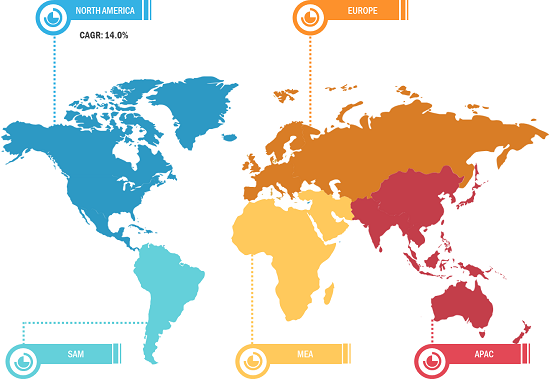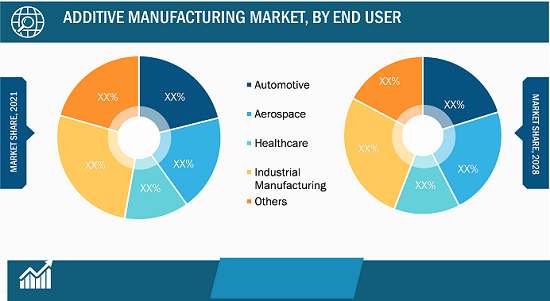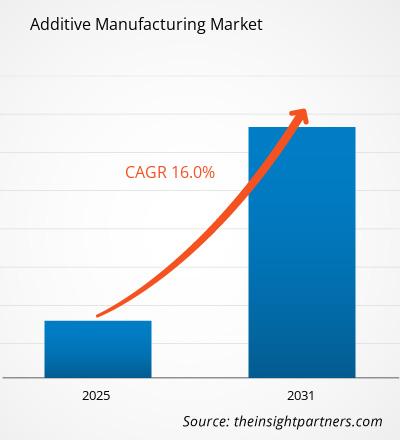Il mercato della produzione additiva è stato valutato a 10.383,02 milioni di dollari nel 2022 e si prevede che raggiungerà gli Stati Uniti 25.171,78 milioni di dollari entro il 2031; si prevede che crescerà a un CAGR del 16,0% dal 2022 al 2031.
Il mercato della produzione additiva ha registrato una crescita e un'adozione significative nel recente passato e si prevede che registrerà una crescita e un'accettazione sostanziali in futuro. La ragione principale della crescente adozione della produzione additiva è l’aumento della necessità di automazione e di tecnologie economicamente vantaggiose nel settore manifatturiero. L’implementazione di tecnologie di produzione additiva nel settore manifatturiero facilita la produzione in serie di parti dalla forma complessa con tempi di consegna ridotti. La produzione additiva ha sostituito i metodi tradizionali grazie alla sua elevata precisione e velocità di produzione. Inoltre, la produzione additiva sta trasformando la produzione in una vasta gamma di applicazioni.
In Nel 2021, il Nord America deteneva la quota maggiore di ricavi nel mercato globale della produzione additiva. L’elevata domanda da parte dei settori manifatturieri come quello automobilistico, sanitario e dei beni di consumo sta trainando principalmente il mercato della produzione additiva nella regione. La produzione additiva è estremamente rilevante per vari settori. L’industria automobilistica è uno dei principali utilizzatori della produzione additiva. La natura competitiva e dinamica dell’industria automobilistica si traduce nello sviluppo di nuove tecnologie in Nord America. Inoltre, un aumento dell’uso della produzione additiva tra gli OEM alimenterebbe la necessità di catene di fornitura e innovazioni migliori. Il mercato di massa dei settori che utilizzano la stampa 3D, compreso l'industria automobilistica , ricopre una posizione essenziale per diffondere l'implementazione di tecnologie che contribuiscano ulteriormente ad abbassare il prezzo sia dei materiali che delle macchine. Le aziende della regione utilizzano principalmente la tecnologia di modellazione della deposizione. La crescente industrializzazione è il fattore principale della crescente domanda di produzione additiva nella regione.
Approfondimenti strategici
Ripartizione del mercato globale della produzione additiva – per regione
 Approfondimenti di mercato
Approfondimenti di mercato
< span style="font-family: verdana, geneva, sans-serif; font-size: 10pt;">Emersione dell'automazione di fabbrica e delle tecnologie basate sul cloud
La fabbrica connessa è un'idea che si è evoluta negli ultimi anni. Significa espandere la potenza del web per collegare macchine, sensori, computer ed esseri umani per consentire nuovi livelli di monitoraggio, raccolta, elaborazione e analisi delle informazioni. Questi dispositivi forniscono maggiore precisione e possono tradurre i dati raccolti in approfondimenti. Ad esempio, possono aiutare a determinare la quantità di tensione utilizzata per produrre un prodotto o a comprendere meglio l'impatto della temperatura, della pressione e dell'umidità sulle prestazioni. I progressi nella tecnologia cloud hanno consentito alle organizzazioni di tutto il mondo di accedere rapidamente alle informazioni essenziali e di creare una facile disponibilità di strumenti e dati per le persone, indipendentemente dal luogo e dal tempo. Inoltre, si prevede che l’iniziativa Industria 4.0 fornirà una visione e un futuro a lungo termine dell’assetto produttivo. Questi fattori sono responsabili della guida del mercato della produzione additiva.
Informazioni sull'utente finale
In base all'utente finale, il livello globale Il mercato della produzione additiva è stato segmentato in automobilistico, aerospaziale, sanitario, manifatturiero industriale e altri. Il segmento della produzione industriale ha detenuto la quota di mercato maggiore nel mercato globale della produzione additiva nel 2021. L’industria manifatturiera globale è in rapida espansione poiché le regioni emergenti investono sempre più nell’adozione di impianti di produzione. L’espansione dell’industria manifatturiera è inoltre fortemente trainata dalla crescita economica mondiale. Questa rivoluzione tecnologica nelle fabbriche ha incoraggiato le industrie manifatturiere a investire ulteriormente nelle tecnologie emergenti per migliorare la loro produttività e il ciclo produttivo. Pertanto, si prevede che la rapida espansione del settore manifatturiero stimolerà la domanda di prototipazione e l'uso di tecnologie 3D in tutto il mondo.
Mercato della produzione additiva, per utente finale – 2021 e 2031
 < /strong>3D Systems; Stratasys, Inc.; Arcam AB; EOS GmbH; 3T RPD, LTD.; Envisiontec Gmbh; Servizi di prototipazione e produzione GPI; Hub 3D; Sciaky, Inc.; e ProtoCAM sono tra i principali attori che operano nel mercato globale della produzione additiva. Gli attori che operano nel mercato globale della produzione additiva si concentrano costantemente su strategie come investimenti in attività di ricerca e sviluppo e lancio di nuovi prodotti.
< /strong>3D Systems; Stratasys, Inc.; Arcam AB; EOS GmbH; 3T RPD, LTD.; Envisiontec Gmbh; Servizi di prototipazione e produzione GPI; Hub 3D; Sciaky, Inc.; e ProtoCAM sono tra i principali attori che operano nel mercato globale della produzione additiva. Gli attori che operano nel mercato globale della produzione additiva si concentrano costantemente su strategie come investimenti in attività di ricerca e sviluppo e lancio di nuovi prodotti.
Segnala Spotlight
- Tendenze progressive del settore nel mercato della produzione additiva per aiutare i giocatori a sviluppare strategie efficaci a lungo termine< /span>
- Strategie di crescita aziendale adottate dai mercati sviluppati e in via di sviluppo
- Analisi quantitativa del mercato della produzione additiva dal 2021 al 2031
- Stima della domanda globale di produzione additiva
- Analisi delle cinque forze di Porter per illustrare l'efficacia di acquirenti e fornitori che operano nel settore
- Recenti sviluppi per comprendere lo scenario del mercato competitivo
- Tendenze e prospettive del mercato, nonché fattori che guidano e frenano la crescita del mercato della produzione additiva
- Assistenza nel processo decisionale evidenziando le strategie di mercato che sostengono l'interesse commerciale, portando alla crescita del mercato
- La dimensione del mercato della produzione additiva in vari nodi
- Panoramica dettagliata e segmentazione del mercato, nonché dinamiche del settore della produzione additiva
- Dimensione del mercato della produzione additiva in varie regioni con promettenti opportunità di crescita
Il mercato globale della produzione additiva è segmentato in base al materiale, alla tecnologia, all'utente finale e alla geografia. In base al materiale, il mercato globale della produzione additiva è segmentato in plastica, metallo, ceramica e altri. In termini della tecnologia, il mercato globale della produzione additiva è segmentato in sinterizzazione laser selettiva (SLS), stereolitografia (SLA), modellazione a deposizione fusa (FDM) e altri. In base all'utente finale, il mercato globale della produzione additiva è segmentato in automobilistico, aerospaziale , assistenza sanitaria e produzione industriale.
Profili aziendali
- 3D Systems
- Stratasys, Inc.
- Arcam AB
- EOS GmbH
- 3T RPD, LTD.
- Envisiontec Gmbh
- Prototipi GPI e servizi di produzione
- 3D Hub
- Sciaky, Inc.
- ProtoCAM
- Analisi storica (2 anni), anno base, previsione (7 anni) con CAGR
- Analisi PEST e SWOT
- Valore/volume delle dimensioni del mercato - Globale, regionale, nazionale
- Industria e panorama competitivo
- Set di dati Excel



Report Coverage
Revenue forecast, Company Analysis, Industry landscape, Growth factors, and Trends

Segment Covered
This text is related
to segments covered.

Regional Scope
North America, Europe, Asia Pacific, Middle East & Africa, South & Central America

Country Scope
This text is related
to country scope.
Trends and growth analysis reports related to Chemicals and Materials : READ MORE..
The List of Companies - Additive Manufacturing Market
- 3D Systems, Inc.
- Stratasys Ltd.
- 3T RPD, LTD.
- Arcam AB
- EOS GmbH
- 3D Hubs B.V.
- ENVISIONTEC, INC.
- ProtoCAM
- Sciaky, Inc.
- GPI Prototype and Manufacturing Services
The Insight Partners performs research in 4 major stages: Data Collection & Secondary Research, Primary Research, Data Analysis and Data Triangulation & Final Review.
- Data Collection and Secondary Research:
As a market research and consulting firm operating from a decade, we have published and advised several client across the globe. First step for any study will start with an assessment of currently available data and insights from existing reports. Further, historical and current market information is collected from Investor Presentations, Annual Reports, SEC Filings, etc., and other information related to company’s performance and market positioning are gathered from Paid Databases (Factiva, Hoovers, and Reuters) and various other publications available in public domain.
Several associations trade associates, technical forums, institutes, societies and organization are accessed to gain technical as well as market related insights through their publications such as research papers, blogs and press releases related to the studies are referred to get cues about the market. Further, white papers, journals, magazines, and other news articles published in last 3 years are scrutinized and analyzed to understand the current market trends.
- Primary Research:
The primarily interview analysis comprise of data obtained from industry participants interview and answers to survey questions gathered by in-house primary team.
For primary research, interviews are conducted with industry experts/CEOs/Marketing Managers/VPs/Subject Matter Experts from both demand and supply side to get a 360-degree view of the market. The primary team conducts several interviews based on the complexity of the markets to understand the various market trends and dynamics which makes research more credible and precise.
A typical research interview fulfils the following functions:
- Provides first-hand information on the market size, market trends, growth trends, competitive landscape, and outlook
- Validates and strengthens in-house secondary research findings
- Develops the analysis team’s expertise and market understanding
Primary research involves email interactions and telephone interviews for each market, category, segment, and sub-segment across geographies. The participants who typically take part in such a process include, but are not limited to:
- Industry participants: VPs, business development managers, market intelligence managers and national sales managers
- Outside experts: Valuation experts, research analysts and key opinion leaders specializing in the electronics and semiconductor industry.
Below is the breakup of our primary respondents by company, designation, and region:

Once we receive the confirmation from primary research sources or primary respondents, we finalize the base year market estimation and forecast the data as per the macroeconomic and microeconomic factors assessed during data collection.
- Data Analysis:
Once data is validated through both secondary as well as primary respondents, we finalize the market estimations by hypothesis formulation and factor analysis at regional and country level.
- Macro-Economic Factor Analysis:
We analyse macroeconomic indicators such the gross domestic product (GDP), increase in the demand for goods and services across industries, technological advancement, regional economic growth, governmental policies, the influence of COVID-19, PEST analysis, and other aspects. This analysis aids in setting benchmarks for various nations/regions and approximating market splits. Additionally, the general trend of the aforementioned components aid in determining the market's development possibilities.
- Country Level Data:
Various factors that are especially aligned to the country are taken into account to determine the market size for a certain area and country, including the presence of vendors, such as headquarters and offices, the country's GDP, demand patterns, and industry growth. To comprehend the market dynamics for the nation, a number of growth variables, inhibitors, application areas, and current market trends are researched. The aforementioned elements aid in determining the country's overall market's growth potential.
- Company Profile:
The “Table of Contents” is formulated by listing and analyzing more than 25 - 30 companies operating in the market ecosystem across geographies. However, we profile only 10 companies as a standard practice in our syndicate reports. These 10 companies comprise leading, emerging, and regional players. Nonetheless, our analysis is not restricted to the 10 listed companies, we also analyze other companies present in the market to develop a holistic view and understand the prevailing trends. The “Company Profiles” section in the report covers key facts, business description, products & services, financial information, SWOT analysis, and key developments. The financial information presented is extracted from the annual reports and official documents of the publicly listed companies. Upon collecting the information for the sections of respective companies, we verify them via various primary sources and then compile the data in respective company profiles. The company level information helps us in deriving the base number as well as in forecasting the market size.
- Developing Base Number:
Aggregation of sales statistics (2020-2022) and macro-economic factor, and other secondary and primary research insights are utilized to arrive at base number and related market shares for 2022. The data gaps are identified in this step and relevant market data is analyzed, collected from paid primary interviews or databases. On finalizing the base year market size, forecasts are developed on the basis of macro-economic, industry and market growth factors and company level analysis.
- Data Triangulation and Final Review:
The market findings and base year market size calculations are validated from supply as well as demand side. Demand side validations are based on macro-economic factor analysis and benchmarks for respective regions and countries. In case of supply side validations, revenues of major companies are estimated (in case not available) based on industry benchmark, approximate number of employees, product portfolio, and primary interviews revenues are gathered. Further revenue from target product/service segment is assessed to avoid overshooting of market statistics. In case of heavy deviations between supply and demand side values, all thes steps are repeated to achieve synchronization.
We follow an iterative model, wherein we share our research findings with Subject Matter Experts (SME’s) and Key Opinion Leaders (KOLs) until consensus view of the market is not formulated – this model negates any drastic deviation in the opinions of experts. Only validated and universally acceptable research findings are quoted in our reports.
We have important check points that we use to validate our research findings – which we call – data triangulation, where we validate the information, we generate from secondary sources with primary interviews and then we re-validate with our internal data bases and Subject matter experts. This comprehensive model enables us to deliver high quality, reliable data in shortest possible time.

 Ottieni un campione gratuito per questo repot
Ottieni un campione gratuito per questo repot